2016 MERCEDES-BENZ GLE battery
[x] Cancel search: batteryPage 173 of 450
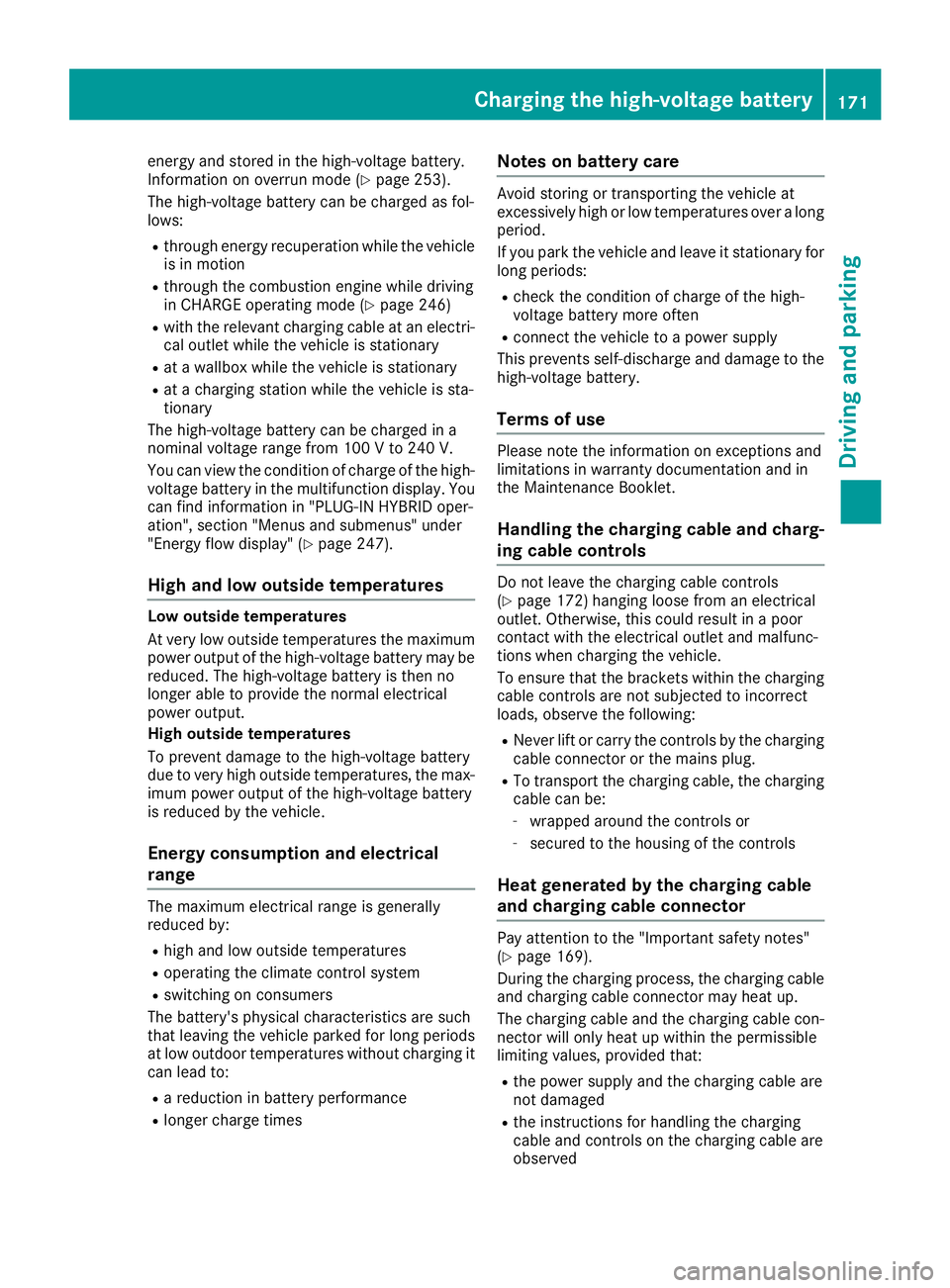
energy and stored in the high-voltage battery.
Information on overrun mode ( Y
page 253).
The high-voltage battery can be charged as fol-
lows: R
through energy recuperation while the vehicle
is in motion R
through the combustion engine while driving
in CHARGE operating mode ( Y
page 246)R
with the relevant charging cable at an electri-
cal outlet while the vehicle is stationary R
at a wallbox while the vehicle is stationary R
at a charging station while the vehicle is sta-
tionary
The high-voltage battery can be charged in a
nominal voltage range from 100 V to 240 V.
You can view the condition of charge of the high-
voltage battery in the multifunction display. You
can find information in "PLUG-IN HYBRID oper-
ation", section "Menus and submenus" under
"Energy flow display" ( Y
page 247).
High and low outside temperatures Low outside temperatures
At very low outside temperatures the maximum
power output of the high-voltage battery may be
reduced. The high-voltage battery is then no
longer able to provide the normal electrical
power output.
High outside temperatures
To prevent damage to the high-voltage battery
due to very high outside temperatures, the max-
imum power output of the high-voltage battery
is reduced by the vehicle.
Energy consumption and electrical
range The maximum electrical range is generally
reduced by: R
high and low outside temperatures R
operating the climate control system R
switching on consumers
The battery's physical characteristics are such
that leaving the vehicle parked for long periods
at low outdoor temperatures without charging it
can lead to: R
a reduction in battery performance R
longer charge times Notes on battery care Avoid storing or transporting the vehicle at
excessively high or low temperatures over a long
period.
If you park the vehicle and leave it stationary for
long periods: R
check the condition of charge of the high-
voltage battery more often R
connect the vehicle to a power supply
This prevents self-discharge and damage to the
high-voltage battery.
Terms of use Please note the information on exceptions and
limitations in warranty documentation and in
the Maintenance Booklet.
Handling the charging cable and charg-
ing cable controls Do not leave the charging cable controls
( Y
page 172) hanging loose from an electrical
outlet. Otherwise, this could result in a poor
contact with the electrical outlet and malfunc-
tions when charging the vehicle.
To ensure that the brackets within the charging
cable controls are not subjected to incorrect
loads, observe the following: R
Never lift or carry the controls by the charging
cable connector or the mains plug. R
To transport the charging cable, the charging
cable can be: -
wrapped around the controls or -
secured to the housing of the controls
Heat generated by the charging cable
and charging cable connector Pay attention to the "Important safety notes"
( Y
page 169).
During the charging process, the charging cable
and charging cable connector may heat up.
The charging cable and the charging cable con-
nector will only heat up within the permissible
limiting values, provided that: R
the power supply and the charging cable are
not damaged R
the instructions for handling the charging
cable and controls on the charging cable are
observedCharging the high-voltage battery 171
Driving and parking Z
Page 174 of 450
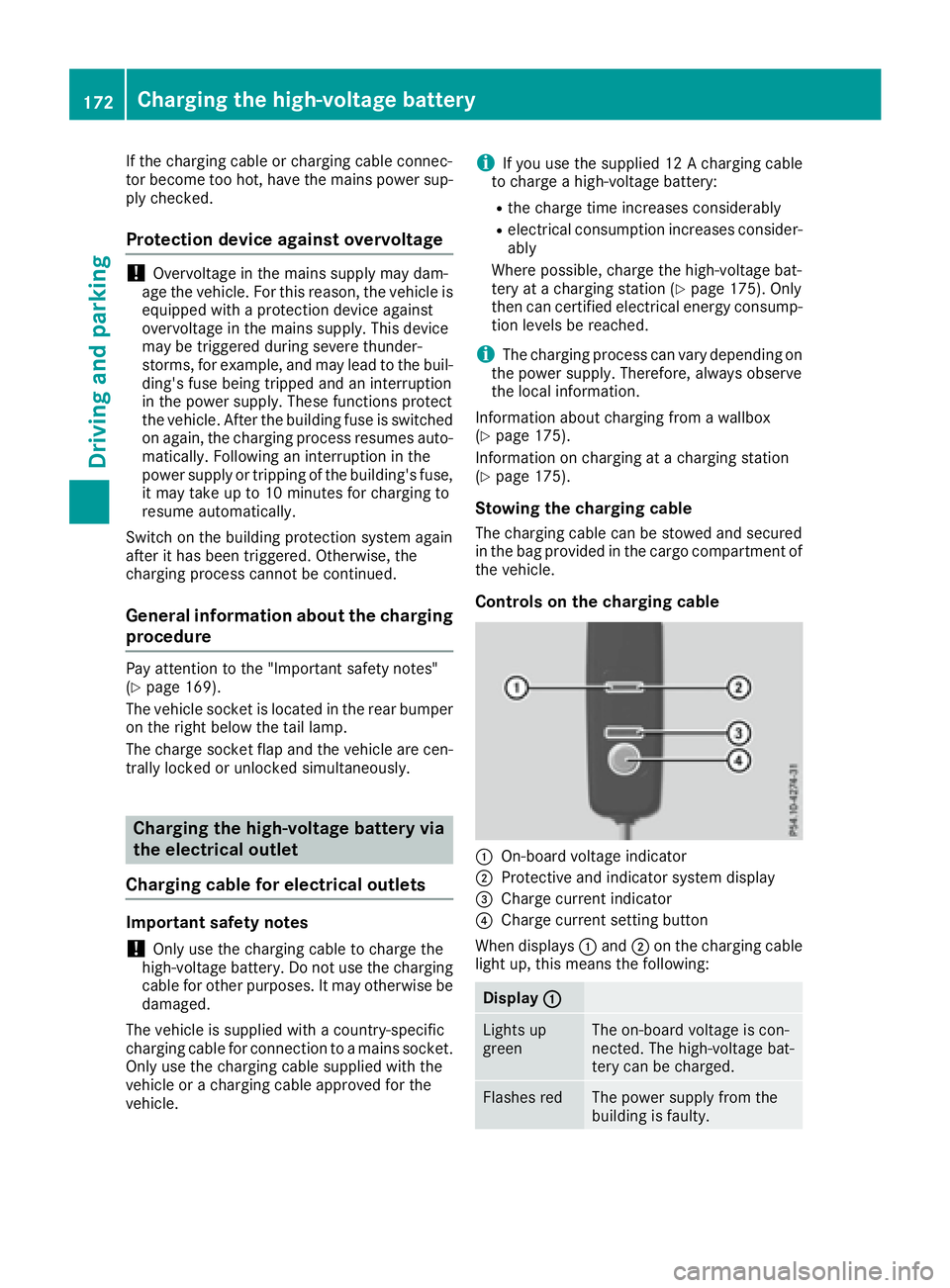
If the charging cable or charging cable connec-
tor become too hot, have the mains power sup-
ply checked.
Protection device against overvoltage
! Overvoltage in the mains supply may dam-
age the vehicle. For this reason, the vehicle is
equipped with a protection device against
overvoltage in the mains supply. This device
may be triggered during severe thunder-
storms, for example, and may lead to the buil-
ding's fuse being tripped and an interruption
in the power supply. These functions protect
the vehicle. After the building fuse is switched
on again, the charging process resumes auto-
matically. Following an interruption in the
power supply or tripping of the building's fuse,
it may take up to 10 minutes for charging to
resume automatically.
Switch on the building protection system again
after it has been triggered. Otherwise, the
charging process cannot be continued.
General information about the charging
procedure Pay attention to the "Important safety notes"
( Y
page 169).
The vehicle socket is located in the rear bumper
on the right below the tail lamp.
The charge socket flap and the vehicle are cen-
trally locked or unlocked simultaneously.
Charging the high-voltage battery via
the electrical outlet
Charging cable for electrical outlets
Important safety notes
! Only use the charging cable to charge the
high-voltage battery. Do not use the charging
cable for other purposes. It may otherwise be
damaged.
The vehicle is supplied with a country-specific
charging cable for connection to a mains socket.
Only use the charging cable supplied with the
vehicle or a charging cable approved for the
vehicle. i If you use the supplied 12 A charging cable
to charge a high-voltage battery: R
the charge time increases considerably R
electrical consumption increases consider-
ably
Where possible, charge the high-voltage bat-
tery at a charging station ( Y
page 175). Only
then can certified electrical energy consump-
tion levels be reached.
i The charging process can vary depending on
the power supply. Therefore, always observe
the local information.
Information about charging from a wallbox
( Y
page 175).
Information on charging at a charging station
( Y
page 175).
Stowing the charging cable The charging cable can be stowed and secured
in the bag provided in the cargo compartment of
the vehicle.
Controls on the charging cable
�C
On-board voltage indicator �D
Protective and indicator system display �
Page 175 of 450
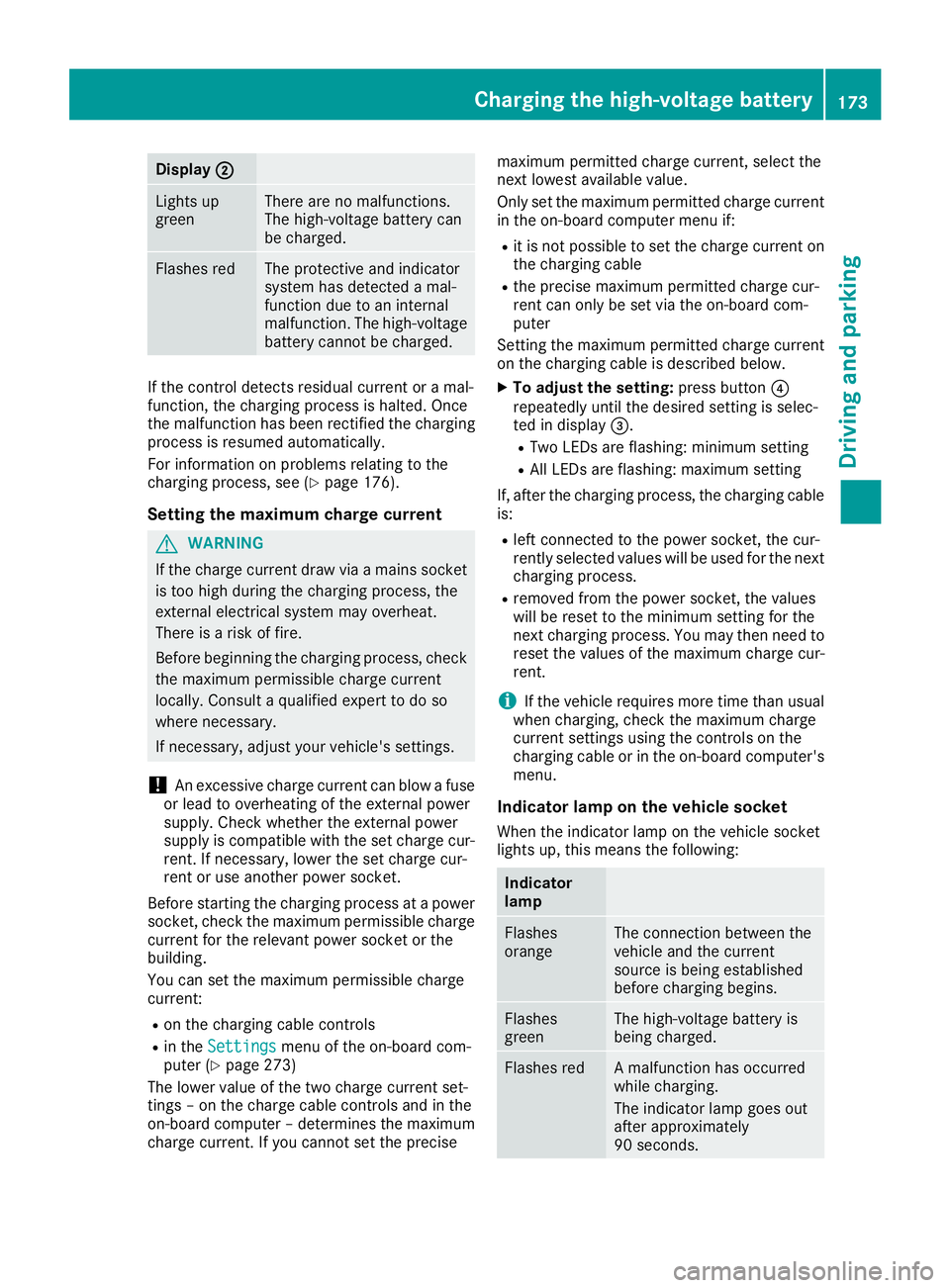
Display �D
Light s up
green There are no malfunctions.
The high-voltage battery can
be charged.
Flashes red The protective and indicator
system has detecte d a mal-
function due to an internal
malfunction . The high-voltage
battery canno t be charged.
If th e control detects residual curren t or a mal-
function , th e charging process is halted. Once
th e malfunction has been rectifie d th e charging
process is resumed automatically.
Fo r information on problem s relating to th e
charging process, see ( Y
page 176).
Setting th e maximum charg e curren t
G WARNIN G
If th e charg e curren t draw via a main s socke t
is to o high during th e charging process, th e
external electrical system may overheat.
There is a ris k of fire.
Befor e beginning th e charging process, chec k
th e maximum permissibl e charg e curren t
locally. Consult a qualified exper t to do so
wher e necessary.
If necessary, adjust your vehicle's settings.
! An excessive charg e curren t can blow a fus e
or lead to overheating of th e external powe r
supply. Chec k whether th e external powe r
supply is compatible wit h th e set charg e cur -
rent. If necessary, lower th e set charg e cur -
ren t or use another powe r socket.
Befor e starting th e charging process at a powe r
socket, chec k th e maximum permissibl e charg e
curren t for th e relevan t powe r socke t or th e
building .
You can set th e maximum permissibl e charg e
current: R
on th e charging cable control sR
in th e Settings men u of th e on-boar d com-
puter ( Y
page 273)
The lower value of th e two charg e curren t set -
ting s – on th e charg e cable control s and in th e
on-boar d computer – determine s th e maximum
charg e current. If you canno t set th e precis e maximum permitte d charg e current, select th e
next lowes t available value .
Only set th e maximum permitte d charg e curren t
in th e on-boar d computer men u if:R
it is no t possibl e to set th e charg e curren t on
th e charging cable R
th e precis e maximum permitte d charg e cur -
ren t can only be set via th e on-boar d com-
puter
Setting th e maximum permitte d charg e curren t
on th e charging cable is described below. X
To adjust th e setting: press butto n �
Page 176 of 450
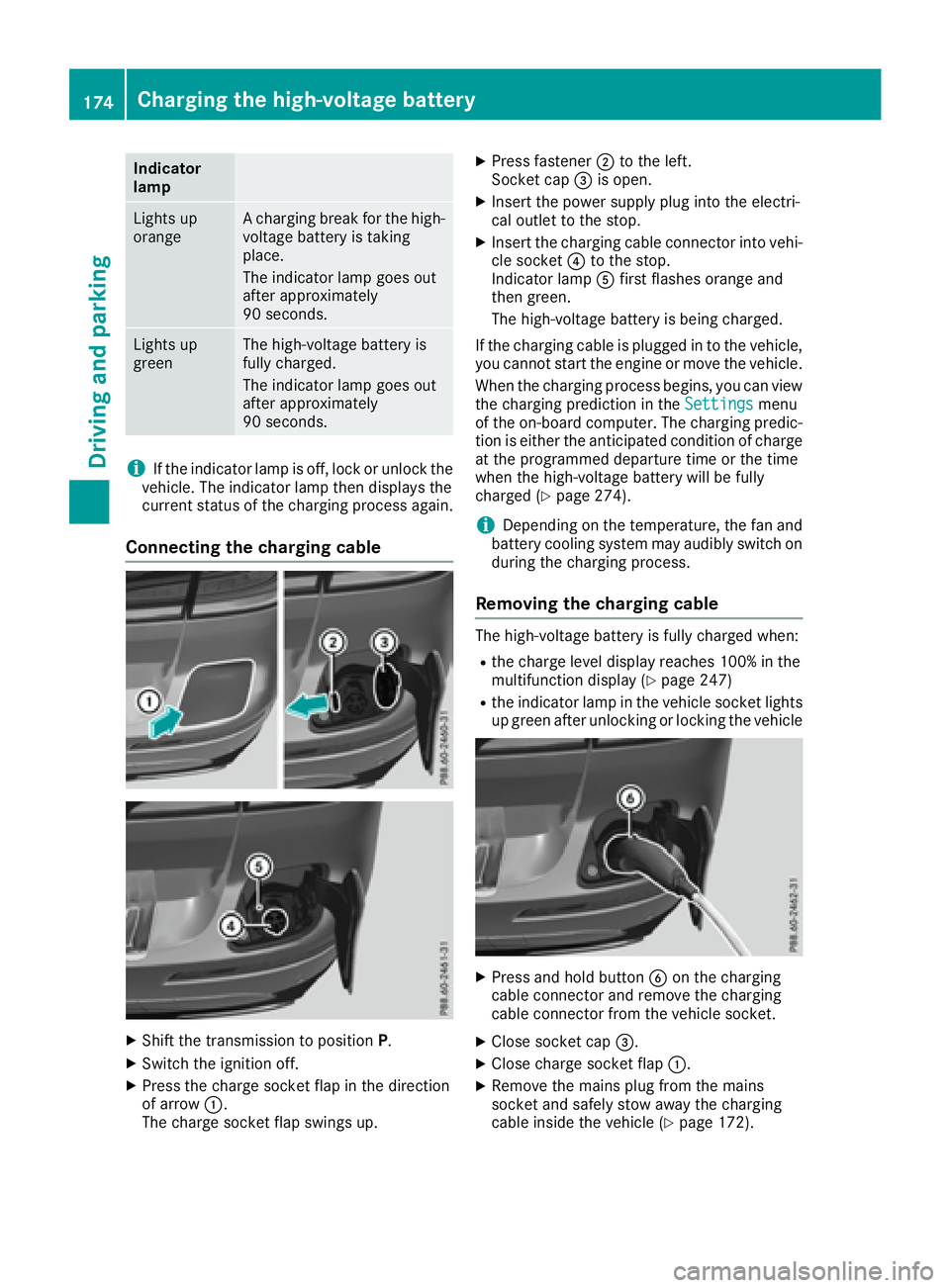
Indicator
lamp
Lights up
orange A charging break for the high-
voltage battery is taking
place.
The indicator lamp goes out
after approximately
90 seconds.
Lights up
green The high-voltage battery is
fully charged.
The indicator lamp goes out
after approximately
90 seconds.
i If the indicator lamp is off, lock or unlock the
vehicle. The indicator lamp then displays the
current status of the charging process again.
Connecting the charging cable
X
Shift the transmission to position P .X
Switch the ignition off. X
Press the charge socket flap in the direction
of arrow �C .
The charge socket flap swings up. X
Press fastener �D to the left.
Socket cap �
Page 177 of 450
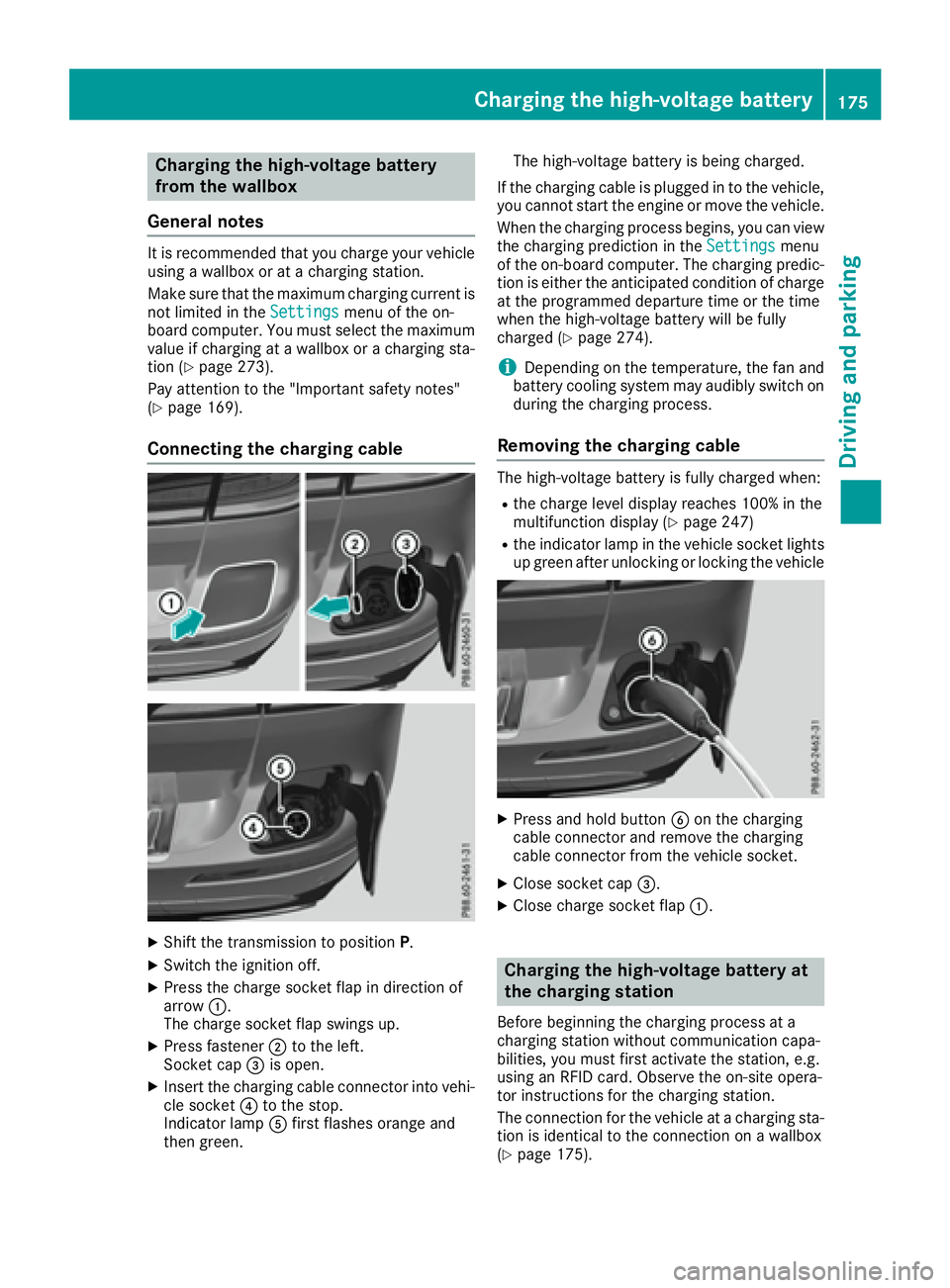
Charging the high-voltage battery
from the wallbox
General notes It is recommended that you charge your vehicle
using a wallbox or at a charging station.
Make sure that the maximum charging current is
not limited in the Settings menu of the on-
board computer. You must select the maximum
value if charging at a wallbox or a charging sta-
tion ( Y
page 273).
Pay attention to the "Important safety notes"
( Y
page 169).
Connecting the charging cable
X
Shift the transmission to position P .X
Switch the ignition off. X
Press the charge socket flap in direction of
arrow �C .
The charge socket flap swings up. X
Press fastener �D to the left.
Socket cap �
Page 178 of 450
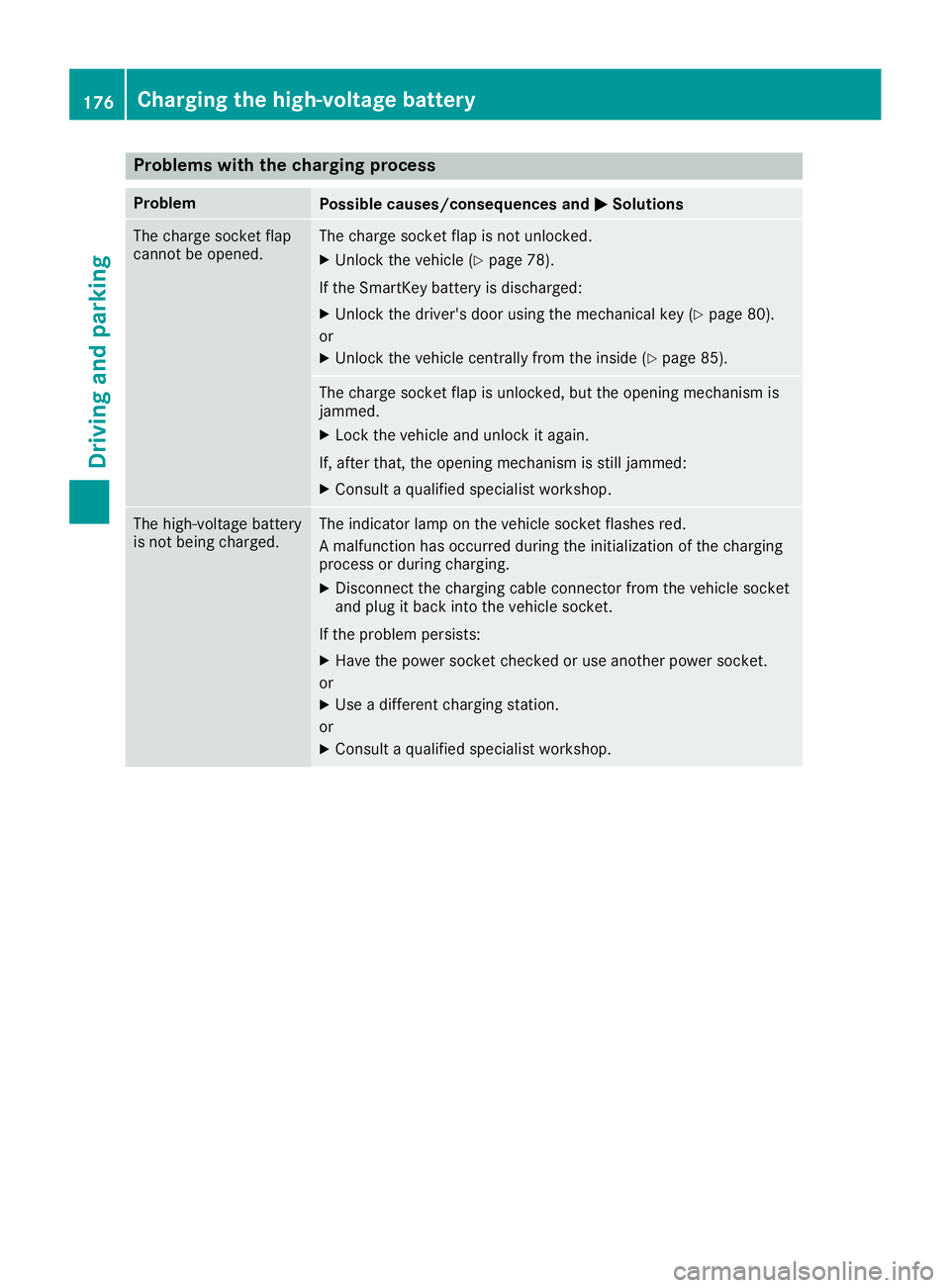
Problems with the charging process Problem
Possible causes/consequences and �P Solutions
The charge socket flap
cannot be opened. The charge socket flap is not unlocked. X
Unlock the vehicle ( Y
page 78).
If the SmartKey battery is discharged: X
Unlock the driver's door using the mechanical key ( Y
page 80).
or X
Unlock the vehicle centrally from the inside ( Y
page 85).
The charge socket flap is unlocked, but the opening mechanism is
jammed. X
Lock the vehicle and unlock it again.
If, after that, the opening mechanism is still jammed: X
Consult a qualified specialist workshop.
The high-voltage battery
is not being charged. The indicator lamp on the vehicle socket flashes red.
A malfunction has occurred during the initialization of the charging
process or during charging. X
Disconnect the charging cable connector from the vehicle socket
and plug it back into the vehicle socket.
If the problem persists: X
Have the power socket checked or use another power socket.
or X
Use a different charging station.
or X
Consult a qualified specialist workshop.176
Charging the high-voltage battery
Driving and parking
Page 179 of 450
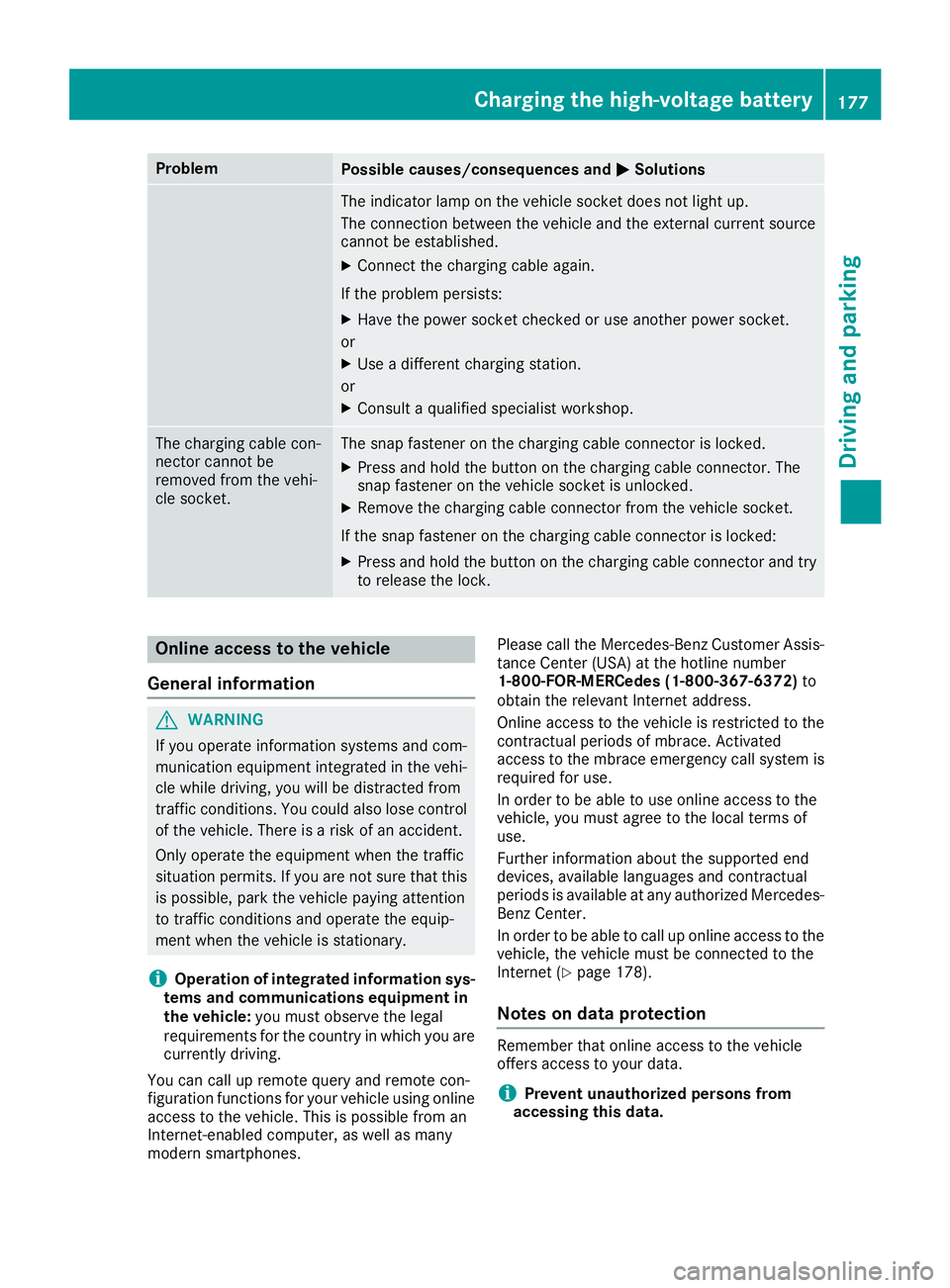
Problem
Possible causes/consequences and �P Solutions
The indicator lamp on the vehicle socket does not light up.
The connection between the vehicle and the external current source
cannot be established. X
Connect the charging cable again.
If the problem persists: X
Have the power socket checked or use another power socket.
or X
Use a different charging station.
or X
Consult a qualified specialist workshop.
The charging cable con-
nector cannot be
removed from the vehi-
cle socket. The snap fastener on the charging cable connector is locked. X
Press and hold the button on the charging cable connector. The
snap fastener on the vehicle socket is unlocked. X
Remove the charging cable connector from the vehicle socket.
If the snap fastener on the charging cable connector is locked: X
Press and hold the button on the charging cable connector and try
to release the lock.
Online access to the vehicle
General information
G WARNING
If you operate information systems and com-
munication equipment integrated in the vehi-
cle while driving, you will be distracted from
traffic conditions. You could also lose control
of the vehicle. There is a risk of an accident.
Only operate the equipment when the traffic
situation permits. If you are not sure that this
is possible, park the vehicle paying attention
to traffic conditions and operate the equip-
ment when the vehicle is stationary.
i Operation of integrated information sys-
tems and communications equipment in
the vehicle: you must observe the legal
requirements for the country in which you are
currently driving.
You can call up remote query and remote con-
figuration functions for your vehicle using online
access to the vehicle. This is possible from an
Internet-enabled computer, as well as many
modern smartphones. Please call the Mercedes-Benz Customer Assis-
tance Center (USA) at the hotline number
1-800-FOR-MERCedes (1-800-367-6372) to
obtain the relevant Internet address.
Online access to the vehicle is restricted to the
contractual periods of mbrace. Activated
access to the mbrace emergency call system is
required for use.
In order to be able to use online access to the
vehicle, you must agree to the local terms of
use.
Further information about the supported end
devices, available languages and contractual
periods is available at any authorized Mercedes-
Benz Center.
In order to be able to call up online access to the
vehicle, the vehicle must be connected to the
Internet ( Y
page 178).
Notes on data protection
Remember that online access to the vehicle
offers access to your data.
i Prevent unauthorized persons from
accessing this data.Charging the high-voltage battery 177
Driving and parking Z
Page 180 of 450

Every person who has access to the informa-
tion stated can use the functions of the online
access to the vehicle.
i Information when selling a vehicle or
buying a used vehicle: R
If you sell your vehicle, you are obliged to
delete the vehicle from your personal area
on the online access to the vehicle. R
If you have bought a used vehicle, it is pos-
sible that the previous owner still has
access to the online access to the vehicle.
Calling up functions The online access to the vehicle allows you
access to your vehicle's information and func-
tions using remote query and remote configu-
ration.
The following functions can be accessed: R
request the current condition of charge of the
high-voltage battery R
program the departure time ( Y
page 274)R
set or activate the "Pre-entry climate control
at departure time" function (see the separate
COMAND operating instructions)
Information on additional functions and operat-
ing instructions can be found within the online
access to the vehicle.
Connecting the vehicle to the Internet
i This function is not available in all countries
and requires activated access to the mbrace
emergency call system.
You can use the online access to the vehicle if
the vehicle has a connection to the Internet via a
mobile phone network. The necessary data is
transmitted by radio. The vehicle automatically
recognizes whether a connection to the Internet
is possible or not. No presets are necessary.
i Restrictions in reception are possible if the
vehicle is in an underground car park, for
example. Restrictions may also occur in areas
with poor mobile network coverage. Parking
Important safety notes
G WARNING
Flammable material such as leaves, grass or
twigs may ignite if they come into contact with
hot parts of the exhaust system or exhaust
gas flow. There is a risk of fire.
Park the vehicle so that no flammable mate-
rials come into contact with parts of the vehi-
cle which are hot. Take particular care not to
park on dry grassland or harvested grain
fields.
G WARNING
If you leave children unsupervised in the vehi-
cle, they could set it in motion by, for example: R
release the parking brake. R
shift the automatic transmission out of the
parking position P .R
start the engine.
In addition, they may operate vehicle equip-
ment and become trapped. There is a risk of
an accident and injury.
When leaving the vehicle, always take the
SmartKey with you and lock the vehicle. Never
leave children unsupervised in the vehicle.
! Always secure the vehicle correctly against
rolling away. Otherwise, the vehicle or its driv-
etrain could be damaged.
To ensure that the vehicle is secured against
rolling away unintentionally: R
the electric parking brake must be applied. R
the transmission must be in position P and the
SmartKey must be removed from the ignition
lock. R
the front wheels must be turned towards the
curb on steep uphill or downhill gradients. R
the empty vehicle must be secured at the
front axle with a wheel chock or similar, for
example, on uphill or downhill gradients. R
a laden vehicle must also be secured at the
rear axle with a wheel chock or s imilar, for
e xample, on uphill or downhill gradients.178
Parking
Driving an d parking